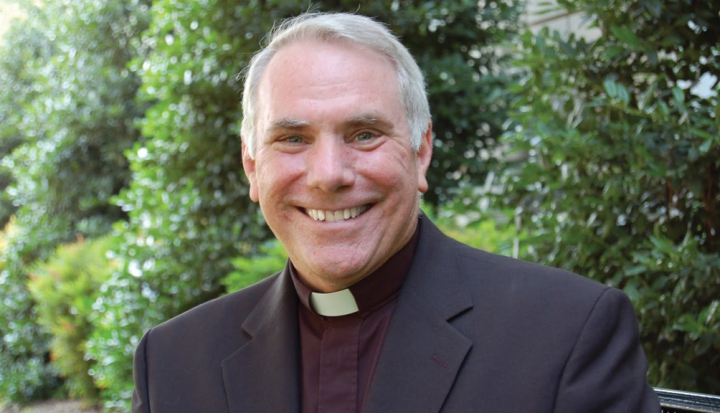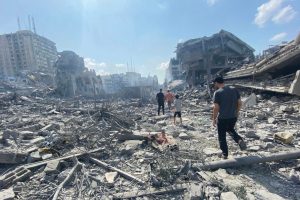If you attend a labor union meeting or a rally for workers’ rights anywhere in the country, don’t be surprised to spot a Catholic priest in the crowd. Priests have long played a key role in the labor movement, helping workers to fight for their rights and spreading the message of Catholic social teaching and the dignity of work. And after becoming less visible in recent decades, the “labor priest” is making a comeback.
Leading the charge is Father Clete Kiley, a priest of the Archdiocese of Chicago. As a young priest, Kiley had many opportunities to help workers and to learn from the previous generation of labor priests. He eventually received the permission of Cardinal Francis George, Chicago’s archbishop at the time, to pursue this work full time as the director of immigration policy for the labor union UNITE HERE.
In 2012, Kiley followed in his mentors’ footsteps by organizing a new generation of priests in the labor movement. Working with the National Federation of Priests’ Councils, Kiley founded the Priest-Labor Initiative, a group of bishops, priests, and scholars committed to supporting worker justice.
In this web-only excerpt from his interview in the September 2015 issue of U.S. Catholic, Kiley discusses the history of the labor priests and their role in the church today.
How did the labor priest movement get started?
If you go back in history, Catholics had a lot of influence in the labor movement. Cardinal James Gibbons, who was the archbishop of Baltimore in the late 19th century, really was a key influence. Cardinal Gibbons defended the Knights of Labor, the country’s first large labor organization, which was really under the gun after the Haymarket Riot. A lot of Catholics were critical of the Knights of Labor and Rome was considering condemning them. Gibbons really went to bat for them in Rome, so much so that history would reveal that he influenced Pope Leo XIII to support labor organizations.
There was a second influential priest around the same time, in the late 1800s, named Msgr. Edward McGlynn. He was known as “the people’s priest.” He was a New York priest, the son of Irish immigrants. He defended the rights of workers but clashed with Cardinal Michael Corrigan, who was the archbishop of New York at that time.
McGlynn built up a number of unions for different trades. A lot of them started in his church basement. The cardinal forbid him to do it and banned him from organizing. McGlynn said, “I’d rather die.” So Corrigan excommunicated him.
When Pope Leo XIII published Rerum Novarum, the encyclical on capital and labor, in 1891, it affirmed everything McGlynn had done. Cardinal Corrigan had no choice but to lift the excommunication and restore McGlynn to the priesthood.
There have been other influential priests. When we did the first training for labor priests with the National Federation of Priests’ Councils we had Professor Joseph McCartin of Georgetown University put together a presentation looking at the history of the U.S. Catholic labor movement through the lives of six priests. What was striking was that by the time we got to the sixth priest, everyone in the room realized that this isn’t just an add-on to the priesthood, or something that priests on the fringes do. This is part of who we are.
Who were the labor priests that influenced you?
My first pastor in Chicago was Msgr. John Hayes. When I was ordained in 1974 I went to his parish, but I never knew his whole history. I had no idea that he’d been sent to Rome and got a doctorate in the late 1930s in Catholic social teaching. He must have been one of the first people to ever get that degree. Then he came back and was sent to Washington to help set up the labor schools. None of that was on my radar when I was assigned to his parish.
I was there with him for three years. I remember the first year—and this became a yearly ritual—he would invite all of the labor priests for lunch. There was a priest from Brooklyn who would always come. There was one from Detroit. Msgr. George Higgins, who was a great, nationally-known labor priest, would always be there, and so would Msgr. Jack Egan. Msgr. Reynold Hillenbrand and his brother Msgr. Fred Hillenbrand would come. It was a fascinating group. As the rookie, my job would be to get more ice, frankly.
They’d get there at noon and would leave at about 5 p.m. It was a long lunch but there were great stories. It was this whole crowd of priests who had this sensitivity to labor issues. That’s what began to make me pay attention to these issues, and to what an extraordinary guy Msgr. Hayes really was. But I suppose that Higgins and Egan were really my mentors.
What did they teach you about helping workers?
One day I got a phone call from Jack Egan. He says, “I’m sending some people to see you.” There were three organizers, and they were trying to organize food service workers at O’Hare International Airport in Chicago. I said, “Jack, what do you want me to do?” He said, “Whatever they need.”
That’s how I first got involved with the UNITE HERE, which was just HERE (Hotel Employees and Restaurant Employees) International Union at the time. So these folks came out to meet me and I listened to them. I was rector at Niles College Seminary at the time, so I gave them a key to a classroom to use. I told them we had a 16‑passenger van if they needed to bring people from O’Hare over to meet with them. I said we’d get them lunch, or open the chapel up for them if they wanted to use it.
Egan somehow got Cardinal Joseph Bernardin to write letters to the food service workers at O’Hare in English, Spanish, and Polish, maybe a few other languages. Then I got seminarians to help. The next thing I know, those guys were out with the letters going through the airport to every food stop in the place. They were so excited, saying to people in Spanish or Polish, “You can have a union. Here’s a letter from Cardinal Bernardin in support of it.” It wasn’t high, preachy theology or anything. It was just, “Here are people in need, you’ve got to do it.”
That was so Jack Egan. It wasn’t, “I’m inviting you to step into Catholic social teaching.” It wasn’t a sermon at all. It was a personal favor to help these people, do whatever you can. And really it was life changing.
How did priests get separated from the labor movement?
I think there are some very significant factors there. When Msgr. Hayes was doing his work in the ‘40s, the big threat was communism, and the labor movement was right at the edge of that. The labor priests took that fight against communism very seriously and they pretty much prevailed. Msgr. Charles Owens Rice of Pittsburgh was one of the great labor priests; he was strongly anti‑communist and made some strong waves.
They got through that period of time. Then you had Father John Corridan, the Jesuit in New York who was the inspiration for the movie On the Waterfront. He was fighting corruption and fighting the influence of mob control.
I think another thing that began to strain the labor priests was the issue of race and civil rights. There were some clergy and some unions that marched in Selma and other things, but other unions did not and really resisted it. So there were those kinds of tensions. The Vietnam War was another one. I think the culture wars of the last several years have created tensions, too.
Msgr. Higgins was really strong on trying to stay out of the culture wars and to stay focused on workers, wages, job safety, those kinds of issues. Once labor started getting mixed with other cultural issues, there starts to be less common ground between the labor movement and the church. And in some dioceses, if a priest wanted to get involved in labor the question was, “Aren’t you busy enough that you don’t need to get involved with that?”
But when you actually talk to people about the issues they deal with at their work today, it feels like you’re back in 1890. Nothing has changed. I think that’s why there’s been a reawakening for priests on this issue.
Are labor priests making a comeback?
As I began to meet priests in different parts of the country who were leading immigrant advocacy groups, they would often talk about what these immigrants are dealing with when they go to work. I saw those priests had the fire. Sometimes they would get hooked up with interfaith groups like Clergy & Laity United for Economic Justice in California, or Interfaith Worker Justice in Chicago. I began to realize that I’m not the only labor priest. There are labor priests all over, we’re just not organized.
I said the same thing to our union president when I was with him at an AFL-CIO meeting. This was probably three and a half years ago. I don’t know how he did it, but the next thing I know, I’m sitting next to AFL-CIO president Richard Trumka, who wanted to hear what I had to say.
I told him there were priests all over the country working on labor, but we’re not organized, and who organizes better than the AFL-CIO? Trumka said, “Count us in.” Other labor leaders joined him in that support—from IBEW (International Brotherhood of Electrical Workers), UNITE HERE, United Steelworkers, Laborers International Union, and other unions.
So it has been a collaborative effort, and we started a national training program. We partnered with a lot of other Catholic and interfaith labor groups, and when we did the first training we had 28 priests from across the country.
I would say more than half of them were under 40. Another thing I’ve heard from the older generation is that these young priests today aren’t interested in this. That’s not true. They are, but you’ve got to find the right trigger. Now our list of priests is over 100. Many of those have come to a day-long training or have expressed an interest in doing so.
We’re trying to formalize that training structure. It’s a pretty loose movement at the moment. I’m really adamant that we have to have a structure because otherwise I’ll retire, like Msgr. Higgins and other people retired, and it all will fade again. We don’t want that to happen. We need priests to continue working in the labor movement.
This is a web-only interview that accompanies the print interview with Father Clete Kiley titled “Work in progress,” which appeared in the September 2015 issue of U.S. Catholic (Vol. 80, No. 9, pages 22–25).
Image: Courtesy of Walker Lambert














Add comment